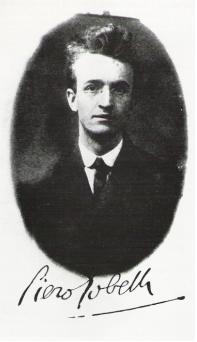Piero Gobetti facts for kids
Piero Gobetti (born June 19, 1901, in Turin, Italy – died February 15, 1926, in Neuilly-sur-Seine, France) was an Italian journalist and thinker. He was a strong supporter of liberal ideas and a brave anti-fascist. He was very active in Italy during the difficult years after World War I and when Fascist rule began.
Biography
Piero Gobetti studied law at the University of Turin. In 1918, he started his own magazine called Energie Nove (New Energies). Through this magazine, he pushed for new ideas in culture and politics. He wanted to change the way traditional politics worked.
Gobetti was inspired by the philosopher Benedetto Croce. He believed that changing culture meant a deep, spiritual change that would connect public and private life. He also supported important causes like improving education and giving women the right to vote.
In 1920, Gobetti was influenced by Antonio Gramsci. Gramsci was a fellow student and a Communist editor. Gramsci was a leading thinker during the workers' protests in Turin from 1919 to 1920. These protests led to workers taking over factories. Gobetti was inspired by the workers' movement. He saw them as a new force for change. Because of this, he stopped editing Energie Nove to think more deeply about his beliefs.
In 1922, he started a new magazine called La Rivoluzione Liberale (Liberal Revolution). Here, he shared his unique view of liberalism. He saw it as a way to achieve freedom, not just a political party's belief. He was deeply moved by the Russian Revolution, which he saw as an event about freedom. Gobetti believed that the working class could lead a liberal revolution. He argued that when workers wanted to take over factories and manage themselves, they showed a desire for independence and shared freedom. He thought this could make Italy new again. Gobetti believed that liberals should see the term 'liberal' as something that could apply to different groups and ways of organizing society, not just the middle class or parliamentary democracy.
Ada Gobetti, a leader in the resistance movement, was his wife. She also wrote for La Rivoluzione Liberale and other magazines.
Gobetti was very aware of the dangers of Benito Mussolini's Fascist Party. The Fascists came to power in October 1922. While some conservative liberals hoped to use Mussolini's popularity to bring back parliament, Gobetti saw that fascism was a cruel and controlling system. He said that fascism showed all the bad parts of Italian society. He argued that fascism continued a political habit of making compromises and taking in opponents, instead of allowing open disagreement. Gobetti believed that liberalism was anti-fascist because it understood that freedom comes from struggle and conflict.
In December 1924, Gobetti also started editing Il Baretti. This was a journal about European literature and culture. He used it to show his idea of liberal anti-fascism. He believed that Italians could learn to reject the narrow-mindedness of fascist culture by learning about European culture.
Death and legacy
Because of his strong opposition to Fascism, Gobetti's magazine was shut down. He was also attacked by Fascist thugs. He was badly beaten in 1925. He then moved to Paris early the next year. He died at the age of 24 in February 1926 from a heart attack. This heart attack was likely caused by the injuries he got from the severe beating by Fascist squadristi. He is buried in Père Lachaise Cemetery.
After his death, even though he didn't write a lot, Gobetti became a symbol of liberal anti-fascism. He inspired many thinkers, like Carlo Levi and Norberto Bobbio.
In the 1973 film The Assassination of Matteotti by Florestano Vancini, Piero Gobetti is played by Stefano Oppedisano.
See also
 In Spanish: Piero Gobetti para niños
In Spanish: Piero Gobetti para niños


